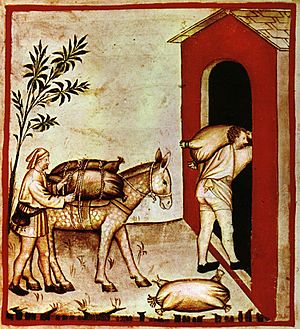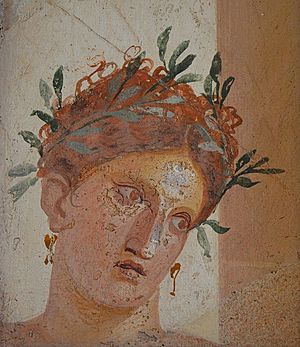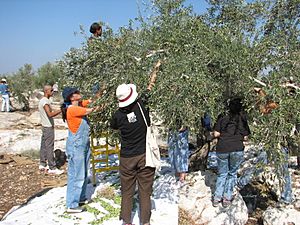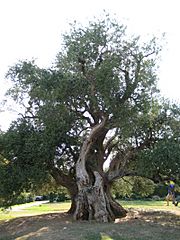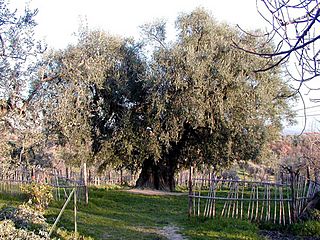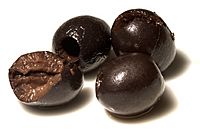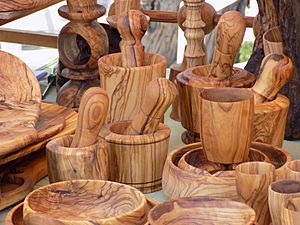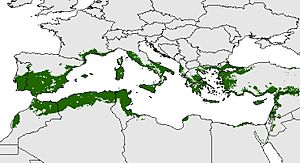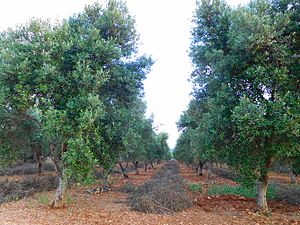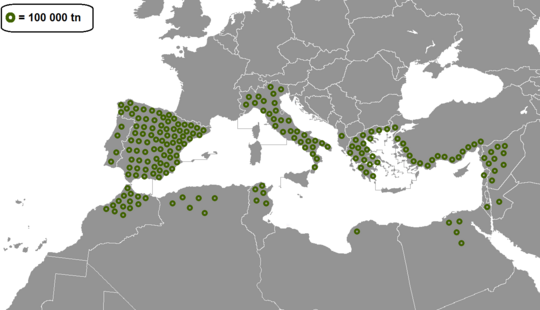Olive facts for kids
Quick facts for kids Olive |
|
|---|---|
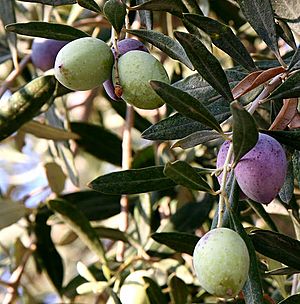 |
|
| Conservation status | |
| Scientific classification | |
| Genus: |
Olea
|
| Species: |
europaea
|
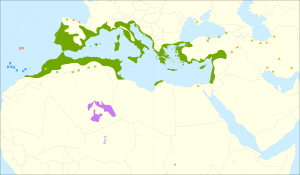 |
|
| Distribution map of Olea europaea s.l. | |
The olive (scientific name: Olea europaea) is a small tree or shrub from the Oleaceae family. It is usually found around the Mediterranean Sea. When it grows as a shrub, it's sometimes called the dwarf olive or little olive. People grow olives in Mediterranean countries, Australia, New Zealand, North and South America, and South Africa. The olive tree and its fruit are so important that they gave their name to the whole Oleaceae plant family, which includes plants like lilac, jasmine, and ash trees.
The olive fruit is super important for farming in the Mediterranean area because it's used to make olive oil. It's also a key ingredient in Middle Eastern and Mediterranean cooking. There are thousands of different types (called cultivars) of olive trees. Some are grown mainly for oil, some for eating, and some for both. Olives grown to be eaten are called "table olives." About 80% of all harvested olives become oil, while 20% are eaten as table olives.
Contents
- What's in a Name? The Word "Olive"
- What Does an Olive Tree Look Like?
- A Look Back: Olive Tree History
- Olives: Symbols and Meanings
- The Oldest Olive Trees
- How We Use Olives
- How Olives Are Grown
- Where Olives Are Produced Globally
- Olive Nutrition Facts
- Can Olives Cause Allergies?
- Images for kids
- See also
What's in a Name? The Word "Olive"
The word olive comes from the Latin word ŏlīva. This word might have come from an older Greek word, *ἐλαίϝα (*elaíwa), which means 'olive fruit' or 'olive tree'. The word oil also originally meant 'olive oil' and came from the Latin word ŏlĕum, which came from the Greek word ἔλαιον (élaion). So, the name of this tree and its fruit is the origin of the word 'oil' in many languages!
What Does an Olive Tree Look Like?
The olive tree, Olea europaea, is an evergreen tree or shrub. This means it keeps its leaves all year round. It grows naturally in Mediterranean Europe, Asia, and Africa. Olive trees are usually short and wide, rarely growing taller than 8 to 15 meters (26 to 49 feet). However, a special type called 'Pisciottana' in southern Italy can grow much taller.
The leaves are a pretty silvery-green color and are about 4 to 10 cm (1.5 to 4 inches) long. The tree's trunk often looks twisted and gnarled, which means it has many bumps and turns.
Olive Flowers and Fruit
Olive trees have small, white, feathery flowers. These flowers usually grow on the wood from the previous year.
The fruit of the olive tree is a small, round fruit called a drupe. It's about 1 to 2.5 cm (0.4 to 1 inch) long when it's ripe. Wild olive trees have smaller fruits with thinner flesh than the olives grown on farms. Olives are picked when they are green or purple. Inside the olive fruit is a hard seed, often called a "pit" or "stone."
Different Kinds of Olives (Cultivars)
There are hundreds of different types of olive trees, called cultivars. The type of olive tree affects the fruit's color, size, shape, and how it grows. It also changes the taste and quality of the olive oil. Some olive types are grown mainly for oil, some for eating, and some for both. Olives grown for eating are called "table olives."
Many olive types cannot fertilize themselves. So, farmers usually plant them in pairs: a main type and a second type that helps fertilize the first. Recently, people have been trying to create new hybrid types that are stronger, grow faster, or produce more olives.
A Look Back: Olive Tree History
Olives in the Mediterranean Region
Scientists believe the olive tree first appeared about 20 to 40 million years ago in what is now Italy and the eastern Mediterranean. Around 100,000 years ago, people in Morocco (Africa) used olives for fuel and probably for food. Wild olive trees have been collected in the Eastern Mediterranean for about 19,000 years.
The olive plant was first farmed about 7,000 years ago in the Mediterranean. For thousands of years, olives were mostly grown for lamp oil, not for their taste. Evidence like ancient writings, olive pits, and wood pieces found in old tombs show that olives came from the area called the Levant. As early as 3000 BC, olives were grown for business in Crete. They might have even helped the Minoan civilization become rich!
Olives Beyond the Mediterranean
Olives didn't grow naturally in the Americas. Spanish explorers brought olive trees to the New World in the 1500s. The first olive seedlings from Spain were planted in Peru in 1560. Olive farming quickly spread along the dry Pacific coast of South America, where the weather was similar to the Mediterranean. Spanish missionaries brought the tree to California in the 1700s. Olive oil farming became a very successful business there from the 1860s onwards.
In Japan, olive trees were first successfully planted in 1908 on Shodo Island. This island became the main place for growing olives in Japan. In 2016, India also started producing olive oil, planting trees in the Thar Desert.
Because the climate is getting warmer, some small olive farms have even started in cooler parts of Europe and North America since the early 2000s. In 2005, there were about 865 million olive trees worldwide. Most of them were in Mediterranean countries.
Olives: Symbols and Meanings
Ancient Greece
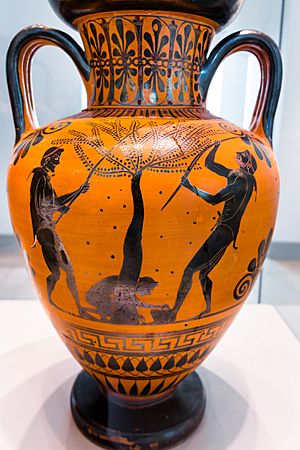
Olives were grown by people at least 5,000 years ago. Along with grain and grapes, they became one of the three main foods that helped ancient societies grow. Olives and olive oil were very important products traded during the Minoan and Mycenaean times.
The ancient Greeks used olive oil for grooming their bodies and hair, believing it was good for health. Olive oil was used to anoint (put oil on) kings and athletes. It burned in sacred lamps in temples and was the "eternal flame" of the first Olympic games. Winners in these games were crowned with olive leaves.
In Greek myths, the goddess Athena won the right to protect Athens by giving the city the gift of the olive tree. The olive tree was sacred to Athena and appeared on Athenian coins.
Ancient Rome
In ancient Rome, a vine, a fig tree, and an olive tree grew in the middle of the Roman Forum. The olive tree was planted to give shade. The Roman poet Horace said that olives, endives, and mallows were part of his simple diet.
The Roman writer Vitruvius wrote that charred olive wood was very strong and lasted forever, even when buried in the earth or water. He said it was used to tie together walls and foundations, making them last a long time.
Judaism and Christianity
Olives were a very important food in ancient Israel. Olive oil was used for food, cooking, lighting lamps, and anointing (blessing) priests or kings. The olive tree is one of the first plants mentioned in the Hebrew Bible (the Christian Old Testament). An olive branch was brought back to Noah by a dove, showing that the great flood was over (Book of Genesis 8:11).
The Mount of Olives, near Jerusalem, is mentioned many times in the New Testament. The Bible compares the Israelites to a tame olive tree and other people (Gentiles) to a wild olive branch.
Islam
The olive tree and olive oil are mentioned seven times in the Quran, the holy book of Islam. The olive is praised as a valuable fruit. The prophet Muhammad is said to have encouraged using olive oil for massage, calling it a "blessed tree." Olives can be used as a substitute for dates during Ramadan fasting.
Palestine
In Palestine, the olive tree is a symbol of strength, health, family ties, and community. For Palestinians, the olive tree helps them survive and feel secure. It shows their deep connection to their land, community, and animals. Olive trees also represent their identity, including their feelings and their cultural values. Many Palestinians see olive trees as proof that Palestine is their homeland.
The olive harvest season is called "Palestine’s wedding." It's a national holiday where children and teachers get two days off school to help with the harvest. This holiday brings community members together and shows their values about family, hard work, and helping others. For example, they have a tradition of leaving some fruit on the trees so that people who don't own land can still pick olives.
United States and United Nations
The Great Seal of the United States, first used in 1782, shows an eagle holding an olive branch. This symbolizes peace. The Flag of the United Nations, adopted in 1946, shows a world map with two olive branches, also representing peace.
The Oldest Olive Trees
Some olive trees are incredibly old!
- An olive tree in Mouriscas, Portugal, called Oliveira do Mouchão, is thought to be about 3,350 years old. It was planted around the beginning of the Bronze Age!
- An olive tree in Bar, Montenegro, is estimated to be between 2,014 and 2,480 years old.
- An olive tree on the island of Brijuni in Croatia is about 1,600 years old. It still produces olives, which are made into olive oil.
- "Plato's Olive Tree" in west Athens was believed to be a remnant of the grove where Plato's Academy was located, making it around 2,400 years old.
- The olive tree of Vouves in Crete is estimated to be between 2,000 and 4,000 years old.
- Some Italian olive trees are thought to date back to Ancient Rome (8th century BC to 5th century AD).
- The village of Bcheale, Lebanon, claims to have the oldest olive trees in the world (some supposedly from 4000 BC), but this isn't scientifically proven.
- Several trees in the Garden of Gethsemane in Jerusalem are said to be from the time of Jesus. Studies show parts of their trunks are from the 11th and 12th centuries AD, but their roots could be much older.
- The 2,000-year-old Bidni olive trees on Malta have been confirmed by carbon dating and are protected.
- Examples of olive trees
-
Karystos, Euboia, Greece
How We Use Olives
The olive tree, Olea europaea, is grown for its olive oil, beautiful wood, and of course, its fruit. About 80% of all harvested olives are turned into oil, while 20% are eaten as table olives. The olive is one of the three main ingredients in Mediterranean cuisine, along with wheat (for bread, pasta) and grapes (for wine).
Olive Oil
Olive oil is a liquid fat made by pressing whole olives. It's often used in cooking, for frying, or as a salad dressing. It's also found in cosmetics, medicines, and soap. In some religions, it's used as a fuel for traditional oil lamps. Spain produces almost half of the world's olive oil. Other big producers include Portugal, Italy, Tunisia, Greece, and Turkey. People in Greece use the most olive oil per person, followed by Italy and Spain.
The type of olive oil depends on the olive type, where it grew, when it was picked, and how the oil was made. It's mostly made of oleic acid. "Extra virgin olive oil" is the highest quality.
Table Olives
Table olives are sorted into three groups based on how ripe they are when picked:
- Green olives are picked when they are full-sized but not yet ripe. They are green to yellow and taste bitter.
- Semi-ripe or turning-color olives are picked when they just start to ripen. Their color changes from green to red or brown, but only the skin changes color.
- Black olives or ripe olives are picked when they are fully ripe. They are purple, brown, or black.
Making Olives Ready to Eat (Curing)
Fresh olives are naturally very bitter. To make them taste good, olives must be "cured" and fermented. This process removes a bitter chemical called oleuropein. Curing can take a few days (using lye) or several months (using salt water or salt). Most curing methods involve bacteria and yeast, which are important for the final taste of the table olives. There are many ways to prepare table olives, depending on local tastes and traditions.
Olive Wood
Olive wood is very hard and strong. People value it for how long it lasts, its beautiful color, and its interesting patterns. Because olive trees grow slowly and are not very big, olive wood products are quite expensive. Olive wood is used to make kitchen tools, carved bowls, cutting boards, nice furniture, and decorations. The wood is often yellow or light greenish-brown with darker lines.
Olive Trees for Decoration
In modern garden design, olive trees are often used for their unique twisted trunks and silvery-gray leaves. They make a beautiful addition to landscapes.
How Olives Are Grown
The first signs of olive farming come from an ancient site in Jordan. Farmers long ago thought olive trees wouldn't grow well far from the sea. Today, we know they prefer coastal areas but can grow inland in places with mild winters.
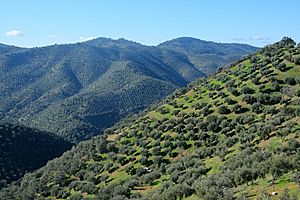
Olives are grown in many parts of the world that have Mediterranean climates, like South Africa, Chile, Australia, and California. They also grow in places with milder climates, like Argentina and New Zealand.
Growing and Caring for Olive Trees
Olive trees love hot weather and sunny spots. Temperatures below -10°C (14°F) can hurt even old trees. They can handle drought well because they have strong, deep roots. Olive trees can keep producing fruit for hundreds of years if they are pruned (trimmed) correctly and regularly.
Olive trees grow very slowly. Over many years, their trunks can become very wide. They rarely grow taller than 15 meters (49 feet) and are usually kept smaller by frequent pruning. Olives are very tough and can resist diseases and fire. Their roots are strong and can even regrow the tree if the part above ground is destroyed.
Old trees sometimes produce a huge amount of olives, but they usually don't have a big harvest two years in a row. Often, a very large harvest happens only every six or seven years. Where olives are carefully grown, like in Italy and France, the trees are regularly pruned. This helps keep the tree low for easy harvesting and makes sure new flowers grow. The ground between the trees is also fertilized regularly.
Pests, Diseases, and Weather Challenges
Many problems can affect olive trees. The most serious pest is the olive fruit fly. This fly lays its eggs in the olive fruit, usually just before it ripens in the autumn. The part of the olive where the egg is laid rots and tastes bitter, making the olive bad for eating or for oil. Farmers use different methods to control this pest, including sprays, traps, and natural bacteria.
A fungus called Cycloconium oleaginum can infect trees for several years, causing a lot of damage. A type of bacterium called Pseudomonas savastanoi pv. oleae causes bumps to grow on the branches. Some caterpillars also eat the leaves and flowers. The Xylella fastidiosa bacteria has attacked olive trees in southern Italy, causing a disease that makes the trees die quickly.
Other pests include the black scale bug, which attaches to the trees and harms the fruit. Rabbits can eat the bark of olive trees, especially young ones, which can kill the tree. Voles and mice can damage the roots. In colder areas, olive trees can be harmed by frost. Strong winds and long periods of rain during harvest time can also cause damage.
Olives as an Invasive Plant
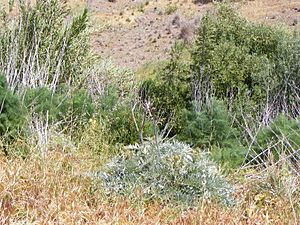
Since olives were first farmed, they have spread back into the wild from planted groves. In some parts of the world where they were introduced, like South Australia, the olive has become a major weed. It takes over areas where native plants used to grow. Its seeds are spread by animals like foxes and birds. These wild olive trees can form thick canopies that stop native trees from growing. Because South Australia is very dry and prone to bushfires, the oil-rich wild olive trees greatly increase the risk of fires.
Harvesting Olives
Olives are harvested in the autumn and winter. In the Northern Hemisphere, green olives are picked from late September to mid-November. In the Southern Hemisphere, green olives are picked from mid-October to late November. Black olives are collected worldwide from mid-November to late January or early February. The exact time depends on the country, the season, and the type of olive.
Most olives today are harvested by shaking the branches or the whole tree. Olives that fall to the ground can be damaged, leading to lower quality oil. Another way is to stand on a ladder and "milk" the olives into a bag tied around the harvester's waist. This method produces high-quality oil. Some farmers use a special net that wraps around the tree trunk and opens like an umbrella to catch the falling fruit. Electric tools with spinning tongs are also used to remove fruit for oil.
Table olives are harder to harvest because workers must be careful not to damage the fruit. Baskets worn around the neck are used. In some mountainous areas, olives are still picked by hand. This prevents bruising and results in a better product. This method also involves cutting off branches, which helps the tree produce more fruit in the future.
The amount of oil in the fruit varies by olive type. The fruit's fleshy part is usually 60–70% oil. A typical olive tree produces about 1.5 to 2.2 kg (3.3 to 4.9 pounds) of oil per year.
Where Olives Are Produced Globally
Olives are one of the most widely grown fruit crops in the world. In 2011, about 9.6 million hectares (23.7 million acres) were planted with olive trees. This is more than twice the land used for apples, bananas, or mangoes. Only coconut trees and oil palms cover more land. The area used for olive farming tripled between 1960 and 1998. The 10 countries that produce the most olives are all in the Mediterranean region, and they produce 95% of the world's olives.
| Country/Region | Production (tonnes) |
Cultivated area (hectares) |
Yield (tonnes/ha) |
|---|---|---|---|
| World | 19,267,000 | 10,650,000 | 1.8091 |
| 11,686,528 | 5,028,637 | 2.3240 | |
| 6,560,000 | 2,573,000 | 2.5490 | |
| 2,343,000 | 887,000 | 2.6414 | |
| 2,092,000 | 1,165,000 | 1.7950 | |
| 1,730,000 | 846,000 | 2.0460 | |
| 1,416,000 | 1,008,000 | 1.4044 | |
| 899,000 | 765,000 | 1.1748 | |
| 700,000 | 1,646,000 | 0.4253 | |
| 697,000 | 424,000 | 1.6437 | |
| 694,000 | 67,000 | 6.7293 | |
| 617,000 | 355,000 | 1.7394 |
Olive Nutrition Facts
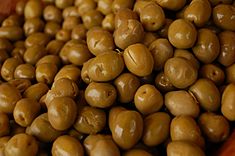
Marinated green olives
|
|
| Nutritional value per 100 g (3.5 oz) | |
|---|---|
| Energy | 609 kJ (146 kcal) |
|
3.84 g
|
|
| Sugars | 0.54 g |
| Dietary fiber | 3.3 g |
|
15.32 g
|
|
| Saturated | 2.029 g |
| Monounsaturated | 11.314 g |
| Polyunsaturated | 1.307 g |
|
Protein
|
1.03 g
|
| Vitamins | Quantity
%DV†
|
| Vitamin A equiv.
beta-Carotene
lutein zeaxanthin
|
3%
20 μg
2%
231 μg510 μg
|
| Thiamine (B1) |
2%
0.021 mg |
| Riboflavin (B2) |
1%
0.007 mg |
| Niacin (B3) |
1%
0.237 mg |
| Vitamin B6 |
2%
0.031 mg |
| Folate (B9) |
1%
3 μg |
| Choline |
3%
14.2 mg |
| Vitamin E |
25%
3.81 mg |
| Vitamin K |
1%
1.4 μg |
| Minerals | Quantity
%DV†
|
| Calcium |
5%
52 mg |
| Iron |
4%
0.49 mg |
| Magnesium |
3%
11 mg |
| Phosphorus |
1%
4 mg |
| Potassium |
1%
42 mg |
| Sodium |
104%
1556 mg |
| Other constituents | Quantity |
| Water | 75.3 g |
|
Full Link to USDA Database entry
|
|
| †Percentages estimated using US recommendations for adults. | |
A 100-gram serving of cured green olives has about 146 calories. They are a good source of vitamin E (25% of what you need daily) and contain a lot of sodium (salt). Other nutrients are not found in large amounts. Green olives are mostly water (75%), with 15% fat, 4% carbohydrates, and 1% protein.
Can Olives Cause Allergies?
Olive tree pollen can cause strong allergies, especially for people with asthma. The pollen is very light and easily carried by the wind. Even a popular type called "Swan Hill," which is sold as "allergy-free," still produces pollen that can cause allergies.
Images for kids
-
Cailletier olives with a harvest net on the ground in Contes, France.
-
Olive trees on Shodo Island, Japan.
-
An olive grove near Alexandroupolis, Greece.
See also
 In Spanish: Olivo para niños
In Spanish: Olivo para niños
- List of olive cultivars
- Moria (tree)
- Olive skin




